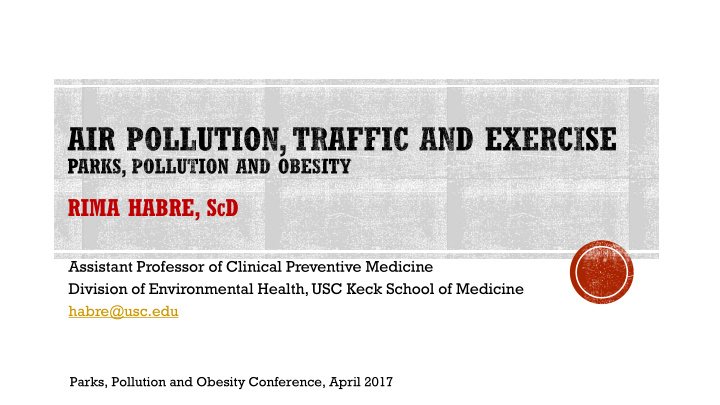



RIMA HABRE, S C D Assistant Professor of Clinical Preventive Medicine Division of Environmental Health, USC Keck School of Medicine habre@usc.edu Parks, Pollution and Obesity Conference, April 2017
Anthropogenic vs natural sources Particulate and gaseous (aerosols) Primary vs secondary The same pollutant can be both sometimes USEPA. http://www.epa.gov/apti/course422/ap3.html
Particles Size (aerodynamic diameter, in micrometers) Counts (particle number, in thousands) Mass (eg, micrograms per meters cubed) Gases Mixing ratio of the gas molecule to air (parts per million, parts per billion, etc..) Roy and Milton, 2004
www.epa.gov/air-sensor-toolbox Directly engages everyone in the process of scientific discovery Data collection by enthusiasts, engaged stakeholders not just scientists Aircasting.org Learning, participation, involvement in community and policy-making process
Safecast.org Habitatmap.org
Formal evaluations of low-cost, air pollution sensors against reference methods In the field and in the lab PM (particulate matter) and gas sensors Look for an R-squared (R 2 ) value as close to 1 as possible
• EPA Citizen Science page: https://www.epa.gov/citizen-science • EPA Air Sensors Toolbox for Citizen Science: https://www.epa.gov/air- sensor-toolbox • Build your own particle sensor, EPA workshop: https://www3.epa.gov/airnow/teachers/gh_pmsensorkit_handoutan dinstructions.pdf • AQ spec program: http://www.aqmd.gov/aq- spec/evaluations/summary • Habitat Map: http://habitatmap.org/ • Safecast: http://blog.safecast.org/
Recommend
More recommend